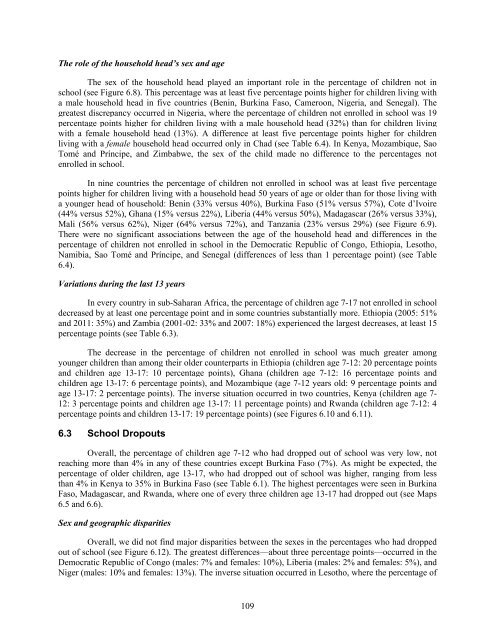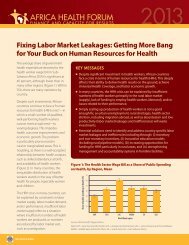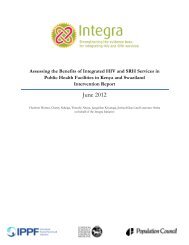ujh78
ujh78
ujh78
You also want an ePaper? Increase the reach of your titles
YUMPU automatically turns print PDFs into web optimized ePapers that Google loves.
The role of the household head’s sex and age<br />
The sex of the household head played an important role in the percentage of children not in<br />
school (see Figure 6.8). This percentage was at least five percentage points higher for children living with<br />
a male household head in five countries (Benin, Burkina Faso, Cameroon, Nigeria, and Senegal). The<br />
greatest discrepancy occurred in Nigeria, where the percentage of children not enrolled in school was 19<br />
percentage points higher for children living with a male household head (32%) than for children living<br />
with a female household head (13%). A difference at least five percentage points higher for children<br />
living with a female household head occurred only in Chad (see Table 6.4). In Kenya, Mozambique, Sao<br />
Tomé and Príncipe, and Zimbabwe, the sex of the child made no difference to the percentages not<br />
enrolled in school.<br />
In nine countries the percentage of children not enrolled in school was at least five percentage<br />
points higher for children living with a household head 50 years of age or older than for those living with<br />
a younger head of household: Benin (33% versus 40%), Burkina Faso (51% versus 57%), Cote d’Ivoire<br />
(44% versus 52%), Ghana (15% versus 22%), Liberia (44% versus 50%), Madagascar (26% versus 33%),<br />
Mali (56% versus 62%), Niger (64% versus 72%), and Tanzania (23% versus 29%) (see Figure 6.9).<br />
There were no significant associations between the age of the household head and differences in the<br />
percentage of children not enrolled in school in the Democratic Republic of Congo, Ethiopia, Lesotho,<br />
Namibia, Sao Tomé and Príncipe, and Senegal (differences of less than 1 percentage point) (see Table<br />
6.4).<br />
Variations during the last 13 years<br />
In every country in sub-Saharan Africa, the percentage of children age 7-17 not enrolled in school<br />
decreased by at least one percentage point and in some countries substantially more. Ethiopia (2005: 51%<br />
and 2011: 35%) and Zambia (2001-02: 33% and 2007: 18%) experienced the largest decreases, at least 15<br />
percentage points (see Table 6.3).<br />
The decrease in the percentage of children not enrolled in school was much greater among<br />
younger children than among their older counterparts in Ethiopia (children age 7-12: 20 percentage points<br />
and children age 13-17: 10 percentage points), Ghana (children age 7-12: 16 percentage points and<br />
children age 13-17: 6 percentage points), and Mozambique (age 7-12 years old: 9 percentage points and<br />
age 13-17: 2 percentage points). The inverse situation occurred in two countries, Kenya (children age 7-<br />
12: 3 percentage points and children age 13-17: 11 percentage points) and Rwanda (children age 7-12: 4<br />
percentage points and children 13-17: 19 percentage points) (see Figures 6.10 and 6.11).<br />
6.3 School Dropouts<br />
Overall, the percentage of children age 7-12 who had dropped out of school was very low, not<br />
reaching more than 4% in any of these countries except Burkina Faso (7%). As might be expected, the<br />
percentage of older children, age 13-17, who had dropped out of school was higher, ranging from less<br />
than 4% in Kenya to 35% in Burkina Faso (see Table 6.1). The highest percentages were seen in Burkina<br />
Faso, Madagascar, and Rwanda, where one of every three children age 13-17 had dropped out (see Maps<br />
6.5 and 6.6).<br />
Sex and geographic disparities<br />
Overall, we did not find major disparities between the sexes in the percentages who had dropped<br />
out of school (see Figure 6.12). The greatest differences—about three percentage points—occurred in the<br />
Democratic Republic of Congo (males: 7% and females: 10%), Liberia (males: 2% and females: 5%), and<br />
Niger (males: 10% and females: 13%). The inverse situation occurred in Lesotho, where the percentage of<br />
109








